The Gay Divorcee (1934)

via: http://thegaydivorceehuey.blogspot.com/p/posterslobby-cards.html Unless otherwise noted, all images are my own
Before Fred Astaire and Ginger Rogers were “Fred and Ginger,” they made this movie. It wasn’t their first film together; that honor goes to 1933’s Flying Down to Rio, but it is the first film featuring Astaire and Rogers as romantic leads. This movie cemented their incredible screen partnership that saw them dance together in ten movies.
In Flying Down to Rio, Astaire and Rogers are supporting players to stars Gene Raymond and Dolores Del Rio, but Astaire and Rogers just about stole the show with the musical extravaganza the “Carioca.” (That’s why the The Gay Divorcee‘s poster declares its stars “the king and queen of ‘Carioca,'” hoping to capitalize on Rio‘s success.) You can watch the Carioca here.
Before Fred Astaire came to Hollywood, he was an established stage star, first with his sister Adele and then on his own. He and Adele made their musical comedy stage debut in 1917 and danced together until she retired in 1932.
After ending such a long, successful partnership with his sister, Astaire was reportedly hesitant to star with Ginger Rogers in this film after dancing with her in Rio because he did not want to be known as one-half of a dance team again. But he needn’t have worried. He’s Fred Astaire!

Fred with his sister Adele via: http://doctormacro.com/Movie%20Star%20Pages/Astaire,%20Fred-Annex.htm
Astaire had strong ties to this film’s story, as The Gay Divorcee was based on a Broadway musical he had starred in called “The Gay Divorce.” This movie is therefore unique in the Astaire-Rogers partnership, as it is the only one that was a film adaptation of one of Astaire’s stage hits.
Fun fact: “The Gay Divorce” was also the first show Fred was in without Adele. She retired in March 1932, and he opened in “The Gay Divorce” eight months later in November. After performing on Broadway for several months, he went to Hollywood to film Flying Down to Rio in the summer of 1933, before returning to “The Gay Divorce” for its London run.
Another fun fact: Most sources claim that the title change from the play’s “Divorce” to the film’s “Divorcee” was due to the Production Code. The Hays Office was uncomfortable with the idea of a “gay divorce” (remember, gay means happy), but okay with the idea of a “gay divorcee.” Apparently, a divorce cannot be happy and lighthearted, but a divorcee sure can! (For more on the Production Code, read my post here.)
Another fun fact qualifying the previous fun fact: In Astaire’s autobiography, he claims that the title was changed because RKO thought it was more “attractive-sounding” since it was “centered around a girl.”
Regardless, “The Gay Divorce” became The Gay Divorcee. Astaire, along with Eric Blore and Erik Rhodes reprised their roles in the film version. Most of the musical’s score was not so lucky, though. The show was written by Dwight Taylor and the marvelous Cole Porter, but only one Porter song, “Night and Day,” made it into the movie.
The rest of the songs in the film were written by songwriting duos Mack Gordon and Harry Revel, and Herb Magidson and Con Conrad, with a score by music director Max Steiner. The movie was directed by Mark Sandrich, who directed five of ten Astaire-Rogers films.
Fred Astaire plays famous dancer Guy Holden (one of the many times he would play a song-and-dance-man) who falls in love with Mimi Glossop (Ginger Rogers). She is less enthused. Mimi has a flighty Aunt Hortense (played by Alice Brady, the mother in My Man Godfrey), and Guy has a flighty best buddy Egbert (Edward Everett Horton). How perfectly 1930s are all these names?
Erik Rhodes plays Tonetti, the “co-respondent,” Eric Blore (Barbara Stanwyck’s “English uncle” in The Lady Eve and Joel McCrea’s valet in Sullivan’s Travels) appears as a very amusing waiter, and seventeen-year-old Betty Grable drops in for a musical number. Off we go!
In a typical 1930s montage, we set our scene in Paris, which seems to have been chosen only to give our characters an excuse to come back to London.
Guy and Egbert are dining at the “Revue Intime” where dancers stand on a rotating stage and dance with finger puppets. Because why not?
There is even a “finger-puppet girl” with awesome sleeves who passes the little tutu-ed dancers to the guests. Again, why not?
The finger-puppet thing sets up our introduction to Guy, who, unsurprisingly, is a whiz with his tiny dancer. It’s cute to introduce Astaire dancing with his fingers instead of his tapping feet, right?
Guy’s best pal Egbert struggles to emulate his friend, but Egbert isn’t a world-famous dancer as Guy is. He’s an anxious, easily flummoxed lawyer working in his father’s firm, and he’s adorable. Horton also played Astaire’s sidekick in Top Hat (1935) and Shall We Dance (1937). His awkwardly dignified buffoonery plays well with Astaire’s confident quickness.
Egbert asks for the check in terrible French then gets a fright when he can’t find his wallet. Guy mocks him until he discovers that his wallet must be in his other coat, too…
Oh, dear. The club’s manager doesn’t know either gentleman and so refuses their IOU. Egbert decides the only way to prove their identities and avoid washing dishes is for Guy to dance and prove that he is the real Guy Holden.
Guy doesn’t love this idea–he’s on vacation! But he reluctantly starts dancing, and pretty soon he loses himself in his virtuosic performance.
Everyone wins: the club gets a free performance by a big star, and Egbert and Guy get a free dinner. At the very end of the song, however, Egbert discovers that he had his wallet all along! Comedy!
Next thing we know, we get an elaborate montage of choppy waves and ships, which signals Guy and Egbert’s crossing to England. They arrive without incident, but the same cannot be said of Hortense (Alice Brady). She is struggling at Customs to declare all of her French purchases. One of the fun things about this movie is that the main plot winds through several detours where terrific character actors like Horton, Brady, and Blore get side-scenes showcasing their gifts.
No one can play batty, almost incomprehensibly flighty women like Alice Brady. She’s a nightmare for normal, rational people because she is just that scatterbrained! For example, she can’t remember where she bought that dress, and so the customs officials start naming French towns to jog her memory. When they ask her if she bought it in Nice, she says, “Niece! Yes, that’s who I’m waiting for!” She’s impossible.
Her niece Mimi (Ginger Rogers) arrives and offers to help re-pack her trunks. As Mimi packs one trunk, her aunt mistakenly pulls a piece of Mimi’s long dress into a drawer, then shuts and locks the trunk before going off with the Customs officials to their office.
Mimi doesn’t realize what has happened until she is alone, and very well stuck with her lovely legs exposed!
She calls timidly for a porter, trying not to draw attention to her embarrassing situation.
Fun fact: Joseph Breen, chief of the Production Code Administration, wrote RKO that “the scenes having to do with Mimi’s skirt being caught in the locked trunk should all be handled with great care to avoid any objectionable exposure of her person.” The censors were watching, so everything is mostly decent, just a little awkward.
No porter answers Mimi’s call, but Guy does! Mimi asks him to fetch her aunt, but Guy likes Mimi immediately and enormously, and he wants to rescue this damsel himself. His confidence and stubbornness come off rather badly–Mimi just wants him to call her aunt, but he has other ideas.
As we knew it would, Guy’s efforts to release Mimi end badly. He tears her dress and lends her his trench coat to cover the damage. She is furious and stalks off without giving him her name, and he is too lovesick to realize that this encounter went horribly wrong. You can watch the scene here.
Cut to Guy and Egbert’s apartment. A messenger delivers Guy’s coat, but Mimi did not include a note or her name or anything, which leads a disappointed Guy to wonder if he perhaps did something wrong:
Guy has been pining over Mimi, but without her name or address, he’s having a very hard time finding her. But look at his fascinating angular decanter and glasses:
Later on in the film, Eric Blore delivers coffee in the most enchanting coffee set:
Hurray for art deco! Even if you don’t get into the plots or the musical numbers of these movies, they are fun to watch for the clothes, sets, and knickknacks.
Anyway, Guy is upset but determined to find Mimi even if he has to search every corner of London. He sings and dances his feelings as only Fred Astaire can in a charming number called “Needle in a Haystack.”
Apparently, Guy Holden likes to decorate with zebra. You can watch his dance here.
Guy spends the next two weeks stalking the pavements and scrutinizing female faces looking for his love. One day, as he slowly cruises the London streets in his cunning little car, he neglects to watch where he is going and rear ends another vehicle. Guess who it is?
When Mimi sees Guy, she takes off in a rush. Guy follows, and within a few seconds they are miraculously out of the city and in the woods.
Guy takes a shortcut and uses his handy, recently purchased “Road Closed” sign to trap Mimi. Once again, she is immobilized and at his mercy. It’s what every girl wants: to be chased into the woods and trapped by a stalker. Yikes.
Guy brings out a beautifully packed picnic basket that he has been carrying around for just such an occasion. He offers Mimi an impressive selection of drinks, and also marriage. But Mimi doesn’t want a drink and she certainly doesn’t want to marry Guy; she just wants to get away from him! I love her lines here:
Mimi can’t bring herself to smash their cars, though. (She’s “too economical,” she says.) But eventually Guy lets her go after she tells him her name and takes his phone number.
Here are our two stars between takes of this scene. Although it is set in British woods, it was filmed in California.

via: http://hollywoodlady.tumblr.com/post/76333079435/fred-astaire-with-ginger-rogers-on-the-set-of-the
I love Rogers’ hat and floaty dress, but the ruffles around her neck are a little clownish for my taste. The costumes in this film were designed by Walter Plunkett, who also worked on Million Dollar Mermaid, Summer Stock, Adam’s Rib, and The Most Dangerous Game.
As Guy waits by the telephone for Mimi’s call (he’s optimistic to the point of delusion), Mimi and Hortense take care of some important business. Turns out that Mimi is married! Her husband is a geologist, and they met when he was one of her instructors at school. Sketchy.
 After they were married, her husband took off and Mimi never sees or hears from him unless he wants money.
After they were married, her husband took off and Mimi never sees or hears from him unless he wants money.
She desperately wants a divorce, but her husband won’t grant one (why would he–it’s a pretty sweet deal for him!), and the British courts won’t give her one, otherwise.
This situation brings Hortense and Mimi to a law firm to get some help. Guess which firm they choose? And which lawyer they consult?
In a happy coincidence, Hortense used to know Egbert! As she tells Mimi, giggling, “He was nearly my first husband!” Hortense has been married lots of times; in fact, she can’t remember which last name Egbert knew her by! It sure is lucky that Mimi has an aunt with such vast divorce experience.
While Hortense and Mimi wait, Egbert is in his office playing with his finger puppet. (They had to bring those things back!) He is startled when his secretary comes in to announce his visitors. Edward Everett Horton has the greatest reactions and double takes!
Mimi explains the situation to Egbert and with Hortense’s help they devise a plan involving a seaside hotel, a “co-respondent,” (the person charged with adultery with a spouse in a divorce case) and detectives sent to catch Mimi in (faux) infidelity. Apparently, this is a tried and true method for ending marriages when the husband won’t agree to a divorce. Most husbands tend to ask for a divorce when they find out that their wife is having an affair. Hortense, at least, has had great success with it.
As they scheme, Egbert forgets that he is still wearing his tiny hand-dancer, and Hortense and her giant bow find it terribly amusing!
Mimi finds the whole divorce scheme embarrassing and distasteful, so she leaves Egbert and her aunt to make the final arrangements. Plunkett outdid himself on this complicated coat. Ruffles and pleats must have been in that year!
Egbert decides to go to the seaside hotel in Brightbourne with Hortense and Mimi to oversee everything, and he convinces Guy to come along, too, as a distraction from his one-sided love affair. (Egbert doesn’t realize that his client is Guy’s lady.) Therefore, all our characters will be holed up at the same fancy resort! How charming and convenient!
While Egbert is waiting for Hortense and Mimi to arrive at the hotel, he puts on his best tank-top and belted short-shorts, and finds himself pleasantly occupied by a beautiful blonde in a shiny pantsuit. It is seventeen-year-old Betty Grable, and she is absolutely determined to play with Egbert!
Fun fact: Grable’s costume first appeared on Dolores Del Rio in Flying Down to Rio (1933), the film I mentioned earlier as being the first in which Astaire and Rogers dance together! Here is the costume in its first screen appearance. Thanks to the great website Recycled Movie Costumes for posting it!

Dolores Del Rio in Flying Down to Rio (1933) via: http://www.recycledmoviecostumes.com/postedwardianmodern106.html
Grable sings the odd “Let’s K-nock K-nees” song, with, you guessed it, knee-focused choreography. Soon everybody in the room has joined in. Luckily, they are all excellent dancers.
Grable and Horton regain the spotlight for some ungainly dancing (on Horton’s part), and some brassy, energetic pizzazz on the part of soon-to-be-star and epic pin-up Betty Grable.
It’s all lots of fun until Guy arrives and rather ironically stops the dancing. Wouldn’t you expect Fred Astaire to jump right in and show them how it is done? Instead, he looks disapprovingly at Egbert from his lofty perch above all those foolish dancers.
You can watch “Let’s K-nock K-nees here.” Also, please notice Egbert’s socks and sandals. Just terrific!
Egbert is distressed to find Guy still hopelessly pining for his love. Egbert is also confused by Guy’s attempt at poetic description:
Guy and Egbert part ways for no reason other than that the plot requires Mimi and Guy to be apart for a little while longer. Egbert meets Hortense and Mimi when they arrive in a stunning car. They discuss the plan, but Mimi still refuses to hear details.
She doesn’t want to know who the co-respondent is, so Egbert rather romantically suggests that the co-respondent will reveal himself to Mimi with the password phrase: “Chance is the fool’s name for fate.” Guy had said this to Egbert only a few minutes ago (it was a line in his last show). Surely no trouble can come from using Guy’s line as a password?
The trio parts ways, with Egbert promising to take care of everything. Hortense is clothed in the most terrific daisy-patterned outfit for this scene. Just look at those gloves!
The divorce plan doesn’t start until midnight, so we spend the intervening time with Egbert and Eric Blore. I adore Blore, and I really enjoy these scenes of confusion and word play. You can watch this one here.
After this nonsensical interlude, the co-respondent arrives. It’s Tonetti (Erik Rhodes reprising his role from the stage play) as an Italian adulterer-for-hire.
He assures Egbert that Mimi will be completely safe with him; after all, Tonetti’s slogan is: “Your wife is safe with Tonetti; he prefers spaghetti!” He’s a dweeb. He also struggles mightily with the “chance is the fool’s name for fate” phrase. His Italian gets in the way and he mangles it amusingly. We suspect he may have trouble introducing himself to Mimi, especially because Egbert forgets to tell him her name…
Now that all of our characters have been introduced, let’s get back to our main romantic plot. Nervous Mimi, who fortunately was still able to put on a stunning evening gown and diamonds, dines with her aunt. She sees Guy on his balcony and runs away, but not before he sees her.
She stupidly runs to the deserted oceanside cabana and is trapped, for the third time, by Guy. It’s a good thing he wants to dance with her, not kill her.
As many of their dances do, this one begins with Astaire coaxing a reluctant Rogers to join him.
To the wonderful strains of Cole Porter’s classic “Night and Day,” the only song from the musical that was included in the movie, Guy tenderly and sweetly draws Mimi into the dance.
Fun fact: Astaire didn’t want to include “Night and Day” in the film because he thought that the hit song had been over-exposed. Fortunately for us, he was persuaded otherwise, and gave us this tremendous, utterly classic number.
Mimi’s gown with its paneled, heavily ruffled skirt moves so beautifully; it is somehow full and thickly layered, but cloud-like and airy, too. And also sparkly.
As the dance goes on, reluctant Mimi falls under Guy’s spell. As many have noted, Astaire’s dances, particularly those with Rogers, play out the couple’s courtship, often before the couple has really begun their romance. By performing their love duet, the two prove to themselves and to us that they are perfect for each other, even though sometimes they are barely even acquaintances outside of the dance. It’s magic! You can watch it here.
Fun fact: Although Dave Gould got credit for “staging” the “dance ensembles,” Astaire adapted his choreography from the musical for the film with the help of his frequent collaborator, Hermes Pan. Pan worked mostly on the group numbers, while Gould was responsible for the overall look and camera angles.
After the music ends, Mimi rises from that lovely dip in a daze. This obnoxious man suddenly seems pretty wonderful! Until he says, “Chance is the fool’s name for fate” as he tells her how amazing it is that they are both at the same hotel. She snaps back to reality, horrified that this man whom she is falling in love with is the co-respondent hired to fake an affair! Horrors!
She is suddenly business-like and cold as she tells an astonished Guy to come to her room at midnight. He has no idea what is happening, and is shocked by Mimi’s bold invitation. They part ways.
Guy decides to take Mimi up on her offer, and meets Hortense outside of Mimi’s room. Hortense bubbles on about the situation, but she doesn’t say anything that gives Guy a clue about the whole co-respondent thing, or say anything that might clear up his mistaken identity.
His confusion and her mistake are very amusing.
Guy enters Mimi’s striking white suite where she is waiting in a negligee, very nervous about the whole thing. How awful to have feelings for one’s hired fake-lover! But how lovely to spend time in that awesomely 1930s-movie version of a hotel room! All white with hints of shining chrome and plenty of gentle drapery and lattice accents!
Mimi is necessarily chilly to Guy, who still has no idea that she thinks he is a hired co-respondent! Mimi tells Guy that they are going to sit on different sofas in calm, respectful silence until morning. It’s very confusing for him.
To fill the awkward silence, he begins reciting state capitals, explaining that he used to do that as a boy. Mimi shuts that down quickly:
Guy isn’t acting at all like a hired lover, so Mimi begins to have her doubts. Perhaps she invited the wrong man to her suite? Horrors again! In some clever scripting, everything that Guy says could apply to his real career as a famous dancer, or to a career as a co-respondent. Mimi is confused, and Guy unwittingly makes things worse.
For instance, when Mimi subtly attempts to ask about his “career,” he tells her that he brings “pleasure to thousands of people.” Mimi replies, “Thousands?” in complete shock. She tries again, asking how he began in his line of work. He says that a famous actress got him started…how is Mimi to interpret that? Comedy!
Meanwhile, Tonetti is spending his evening approaching every woman in the hotel with the password, variously and amusingly butchered. He even tries it on Hortense:
At first Hortense thinks nothing of this encounter, but then she realizes that it could have been a mangled attempt at the password…is her niece shut up with the wrong man? Hortense returns to Mimi’s room with her suspicions. A very distressed, conflicted Mimi tells Hortense that she isn’t sure if Guy is the co-respondent, either!
Mimi asks her aunt how in the world she is supposed to behave, and Hortense wisely advises her to “Be feminine and sweet; if you can blend the two!” until she figures out who Guy really is.
Before we get tired of the mistaken identity routine, Tonetti runs into Egbert and gets Mimi’s room number. When the real co-respondent shows up, the whole story comes out.
Guy refuses to leave Mimi alone all night with this almost-gigolo. So Mimi’s faux-affair has become a threesome. But she’s glad to spend time with Guy, and Tonetti doesn’t care what they do, as long as they stay in the room until the detectives show up. He just wants to complete his assignment and get paid!
In a fun bit of irony, Tonetti calls his wife to check in. He hears a man’s voice on the other end, but his wife covers for it by claiming that their nine-year-old son’s voice has changed! Tonetti believes her, but Guy and Mimi don’t fall for it:
Seems that the professional “other man” might be getting two-timed at home!
Anyway, now that Mimi knows who Guy is, she allows herself to enjoy his company and fall even harder for him. They leave Tonetti playing solitaire in the bedroom and head to the balcony to watch the dancing below. Mimi starts to sing along to the new hit “The Continental:”
They both want to leave the suite and join the revelers, but they seem stuck with Tonetti. Then Guy gets an idea and Mimi goes to change, though her negligee is pretty enough to be an evening gown!
Fun fact: James Wingate, Director of the Studio Relations Office of the Production Code Administration, wrote to the producer of this film, Pandro Berman, about this scene specifically.
Wingate wrote that “considering the delicate nature of the subject upon which this script is based…great care should be taken in the scenes dealing with Mimi’s lingerie, and…no intimate article should be used.” He also told Berman that no one should appear in pajamas! Apparently that would be much too suggestive!
Guy, who counts silhouette cutting among his hidden talents, cuts two dancers out of a piece of paper and rigs up a sort of shadow-projection machine using a record player and a lamp. Clever boy! From Tonetti’s vantage point, it looks as though Guy and Mimi are dancing in the living room. They are free to leave! You can watch the scene here.
Guy and Mimi join the dancers doing the Continental and pretty soon the floor is cleared for our two stars, though they are so enamored with each other that they don’t realize it until the end!
“The Continental” dance scene is a twelve minute extravaganza, so after Guy and Mimi finish this first section, the floor fills with black-and-white clad dancers in a grand kaleidoscopic spectacular on RKO’s great white set:
The whole thing is wild and just keeps going on and on. There is a whole section devoted to pretty girls and revolving doors:
Notice how the criss-crossing necklines on the dancers’ gowns mimic Mimi’s dress! It’s almost as if the whole thing was planned!
After the revolving doors we get women diving off of stairs:
And a random singer giving it her all, costume changes, and Eric Blore dancing as he goes about his waiterly duties.
It is a huge show-stopping number which ends with another appearance of our favorite dancers, Guy and Mimi.
Astaire later wrote in his autobiography that the cast rehearsed the dances in the film for six weeks before shooting began. I believe it!
You can watch the beginning and end sequences featuring Astaire and Rogers here.
Fun fact: RKO hoped that “The Continental” would become a dance craze, and the studio publicity department organized demonstrations and Continental parties to drive audiences to the dance and the movie. But the dance never caught on. What did catch on was Venetian blinds! The hotel set, designed by Carroll Clark and Van Nest Polglase, is absolutely full of the horizontal blinds, and apparently sales of Venetian blinds skyrocketed after this film was released!
Here are Astaire and Rogers in their Continental costumes in promotional photos for the film. So lovely!
After rocking “The Continental,” Guy and Mimi return to her room and an enraged Tonetti ties himself to Guy so that he can’t escape again! The next morning, they wake up to room service. Let’s take a moment and appreciate that chrome-decorated door:
Naturally, Eric Blore is the waiter assigned to bring our trio breakfast, and he does so in typical comic fashion. There’s even a little geological detour spurred on by Mimi mentioning that her husband is a geologist:
Despite Blore’s zany waitering, the carefree mood of the night before dissipates for Mimi. Now she is nervous about the coming drama when the detectives will catch her with her “lover.” What she doesn’t know is that Egbert forgot to hire detectives, and instead brought her husband!
But rather than punching Tonetti and storming out whilst shouting about a divorce, Mimi’s husband, played by William Austin, just laughs. He sees through the manufactured “affair” and pegs Tonetti as a hired co-respondent. He still won’t give Mimi a divorce!
All seems lost until earnest Eric Blore says hello to Professor Brown…turns out “Professor Brown” is actually Mimi’s husband, and Eric Blore met him and his “wife” at another hotel. Now Mimi can file for divorce because her husband is caught in an affair! Perfect! You can watch the scene here.
We end this wild excuse for dance numbers with a scene taken straight from the stage show. Mimi and Guy dance around her hotel suite on the sofas, chairs, and tables in a euphoric expression of freedom and love.
This number is a nice echo of the “Needle in a Haystack” dance that Guy performed early on in the movie. He danced on the sofas and chairs of his apartment as he sang about his hopes of finding Mimi. Now that he has found her, and that she loves him, too, they can dance on the furniture together!
This number was also in “The Gay Divorce” stage show, and in Edward Gallafent’s book Astaire and Rogers, he quotes Astaire’s description of the choreography:
It was a spectacular thing on the hazardous side, in which the climax of the number was reached as we waltzed around the room at top speed going over chairs and tables as if they were part of the floor. We took many a fall rehearsing this and occasionally we fell during the show, too, much to the dismay of the audience. When that happened, we would just get up and do it over properly, like the juggler who misses a trick the first time. Then, when it finally worked, the audience would give us twice as much applause (23).
It is a joyous, “slightly hazardous” number requiring absolute precision in position and timing to avert a tumble. Although Astaire and Rogers’ movements look almost casual and spontaneous, if you watch carefully you see how incredibly close they are to falling at any moment, and how hard Astaire is gripping Rogers and vice versa as they waltz up and down the furniture! You can watch it here (start at 1:50).
The Gay Divorcee was nominated for Best Art Direction, Best Picture, Best Score, and Best Sound. But its only win was for Best Song for “The Continental.”
Here’s the trailer–enjoy! You can watch a lovely TCM “Star of the Month” retrospective of Astaire here. For more, follow me on Twitter, tumblr, Pinterest, Instagram at BlondeAtTheFilm, and Facebook. And you can buy this great movie here.







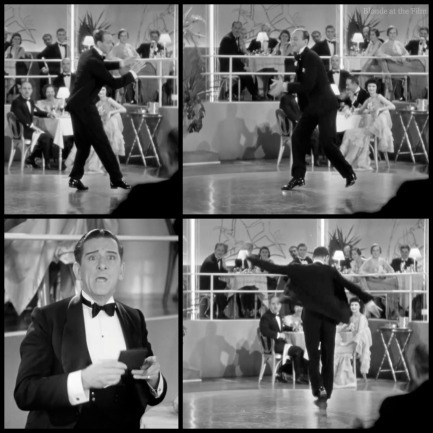


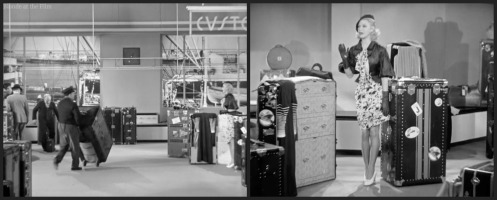


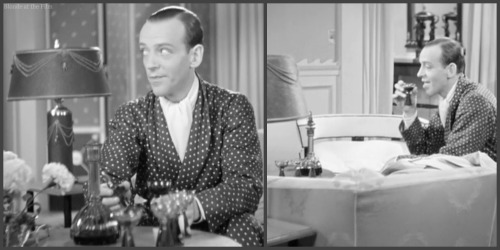

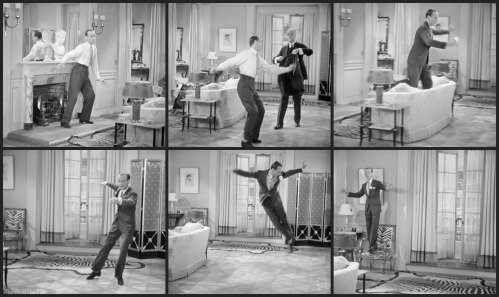






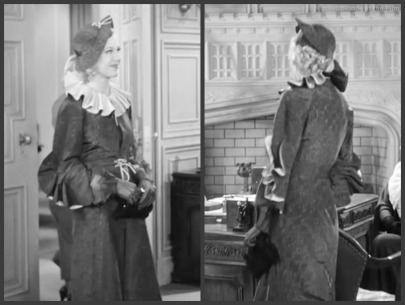


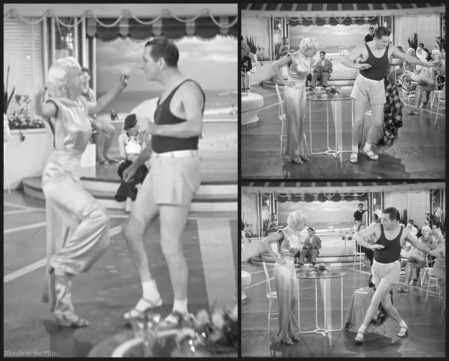








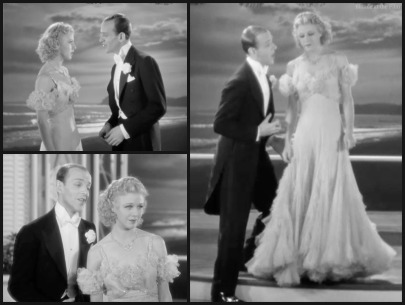

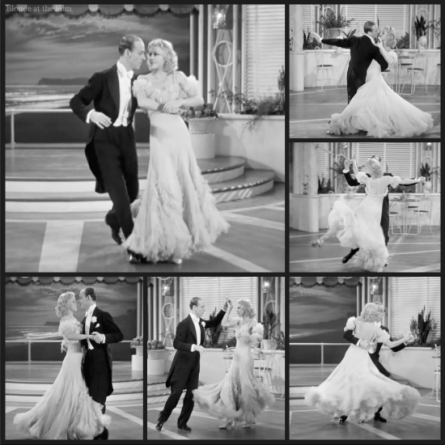
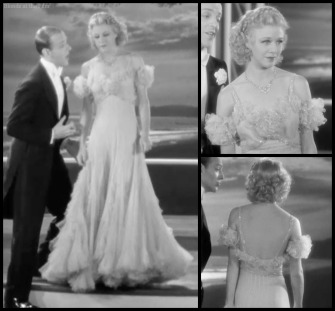






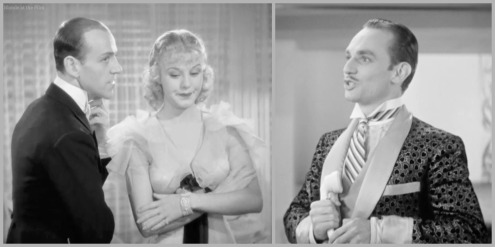
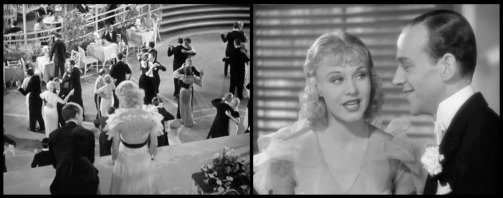



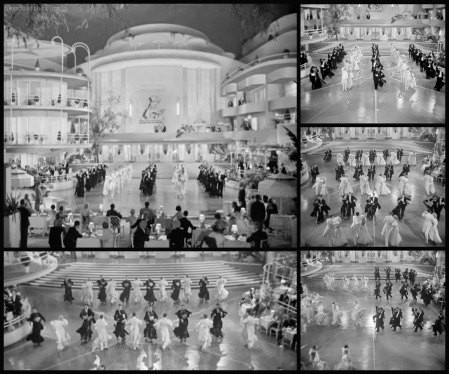




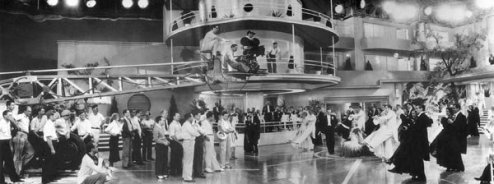

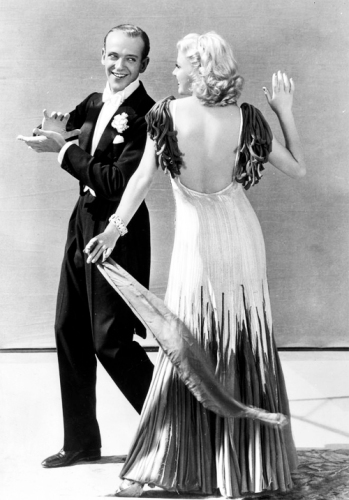



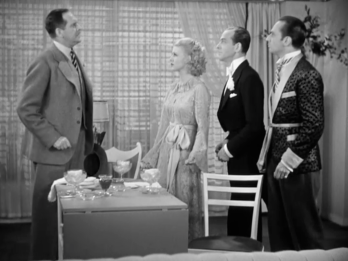

Such riches here. Horton and Blore are comic geniuses, the costumes and sets are stunning, and then there’s the inimitable magic of Rogers and Astaire. My favorite scenes–the skirt caught in the trunk, and the finger puppets!
I agree! Horton and Blore are amazing! And those weird and wonderful finger-puppets! Thanks so much for reading!
I love the “Let’s Knock Knees” number, a terrific representation of silly musical numbers in 1930s movies. Other entries include “Love Me Love My Pekignese” from BORN TO DANCE and “Corned Beef and Cabbage I Love You” from KISS AND MAKE UP. Love these little ditties.
Despite plot similarities to TOP HAT, this remains one of my favorite Astaire Rogers movies, if only for the sheer giddiness of the whole enterpriese. One caveat: I never bought William Austin as Ginger’s husband. Too much of a fussbudget.
I remember seeing this at a revival house in the 1970s and when Erik Rhodes thinking Astaire is a fellow gigolo, asks him, “Are you a union man” the whole audience broke out in laughter, so much so that we missed the next couple lines of dialouge.
I had a chuckle out of your commnet about one of Ginger’s costumes and the ruffles around her neck looking too clownish. Hadn’t thought of that but you are right.
Thanks for this comment! You’re right, there is something so silly about all of it, and about so many other musical numbers and plots in the 1930s! Delightfully silly! And I don’t think Ginger would ever go for someone like William Austin, either! Thanks for reading!
Back again to your blog. Everybody associates Fred and Ginger with ballroom dancing but in 1979 (or about then) interview with Fred Astaire on Johnny Carson, Fred said he rarely did ballroom. Huh? I would say ballroom is where there is a lead/follow connection, what he did with Ginger and others was “show dancing” with “show steps” rather than lead/follow. There is a difference (I’ve danced with ladies that do more show dance rather than ballroom dance and it seems they have their own metronome). But that’s a nitpick.
Ginger was an actress who learned to dance for the movies unlike Cyd Charrise was a dancer who then learned acting for the movies. But then Ginger did it well (and those rehearsals must have been grueling, it is probably easier to train for a spaceflight). I heard Joan Crawford wanted to be a dancer but after watching Ginger, she then concentrated on acting.
Barrie Chase, Astaire’s dance partner for TV show in 1960s, said his dancing was so exact that you can freeze any frame from his movies and you will not see a foot or hand in a weird position. This kind of skill is very difficult to achieve.
Also during this time of the heyday of Fred and Ginger dance movies (cutting edge of show dance techniques), Alex Moore wrote the book that documented ballroom dancing, and here’s a clip filmed two years after this movie’s release,
This was the cutting edge of dance technique at the time, and some of this is still challenging for many ballroom dancers.
Thanks so much for this information and the clip! How cool! Thanks for reading!
Another about Fred Astaire, he was not much of a party guy even said so when he was interviewed by Johnny Carson. A ballroom dance instructor who met him at a social party, probably in 1970s, and she said he was fairly quiet. Fred would engage in conversation but if you didn’t know who he was, you’d think he just a ordinary joe.
I can visualize: “hey Fred, I heard you’re a dancer, what level? Open pro, pro-am, did you compete at blackpool?” No, I never did ballroom. Did some dancing in movies and TV. “Really? Any big films?” Oh a few. “What was it like?” A lot rehearsal and practice.
Fabulous! So much info I should have known. Thanks for putting such a great deal of work into this. I was just trying to recall if Grable was in this film–who could forget E E Horton’s knees? Anyway look what I found! My gratitude to you for tremendous effort in both words and pictures!
Thank you! So glad you enjoyed it! And those knees are something special!